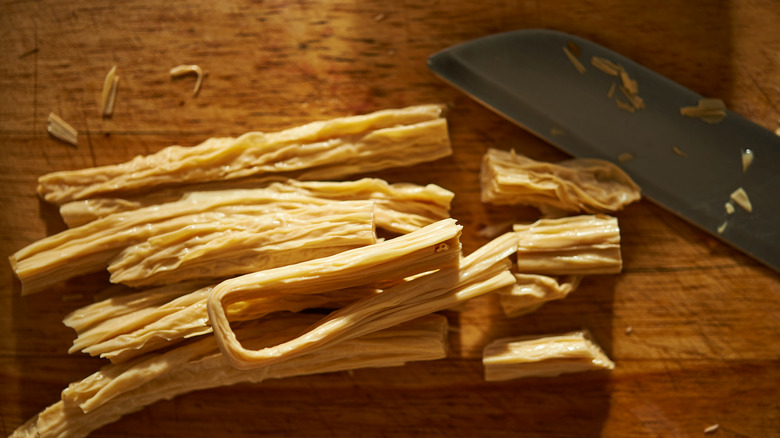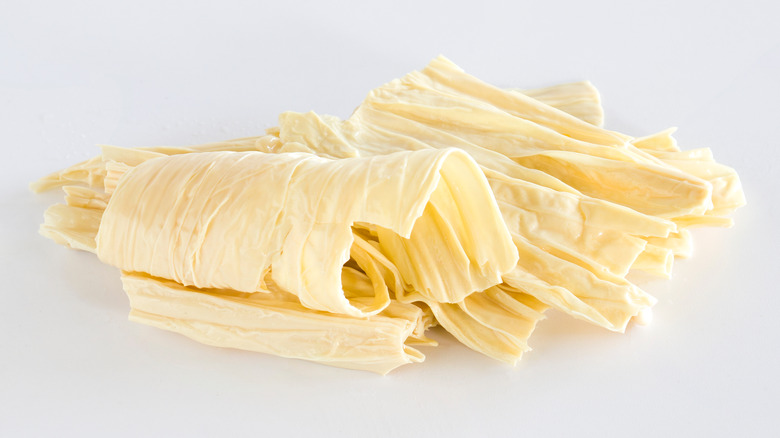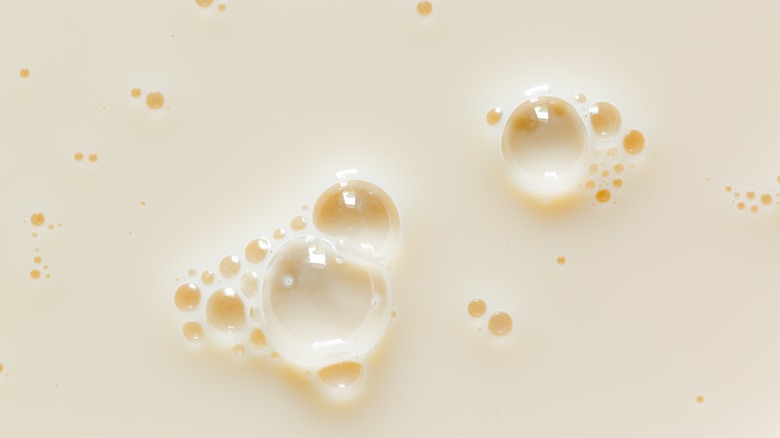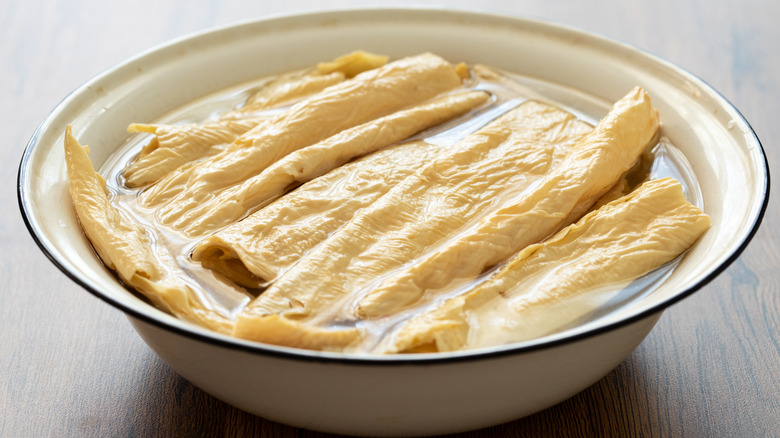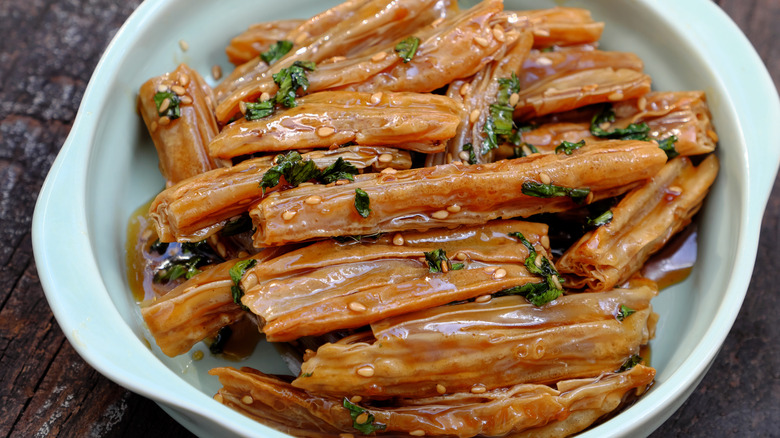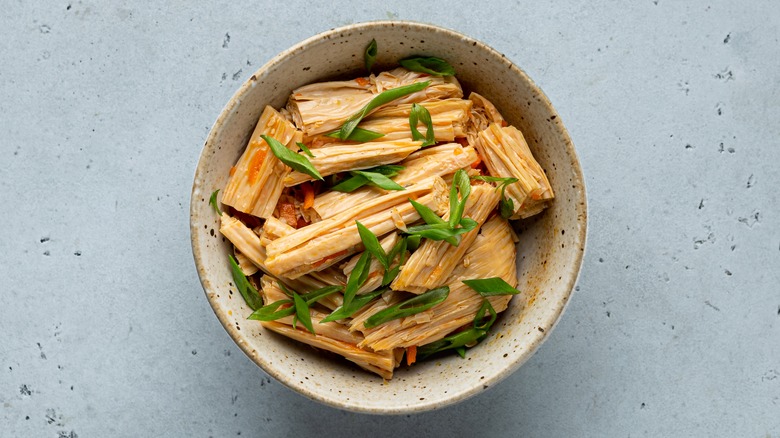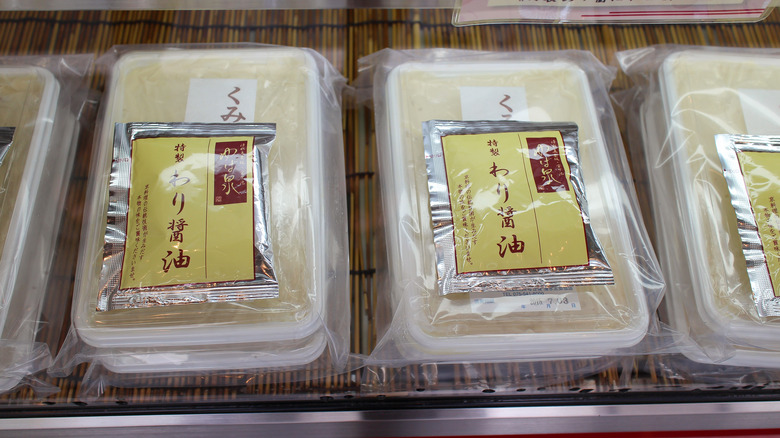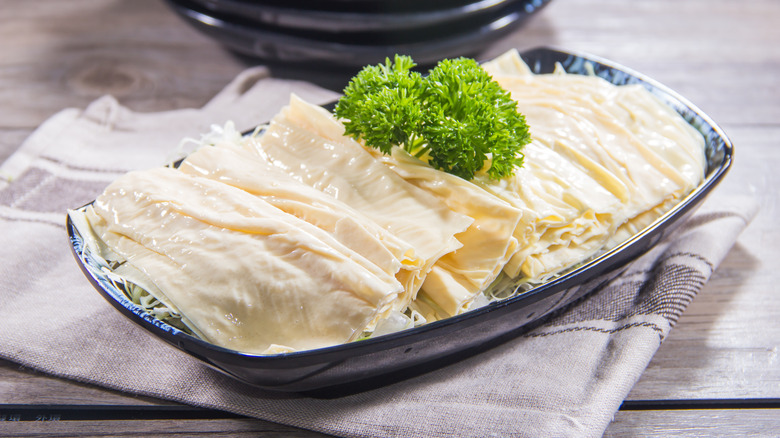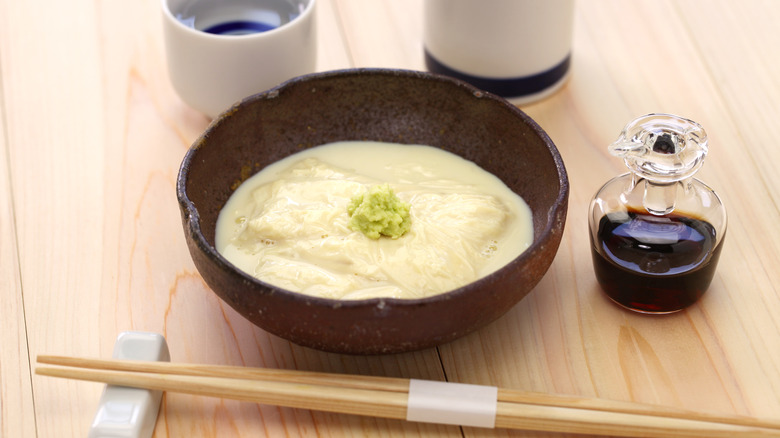What Is Tofu Skin And How Do You Use It?
Tofu is associated with a plethora of potential health benefits, such as lowering cholesterol levels, improving heart health, stabilizing blood pressure, boosting memory, preventing bone loss, and even making your skin more elastic and youthful-looking, per WebMD. With so many positive qualities, tofu products are worth some serious culinary consideration.
But for those who dislike the texture of bean curd, adding this protein-packed ingredient into vegetable stir fry recipes and other dishes might not be so pleasant. In that case, tofu skin is the perfect alternative to include in your kitchen's repertoire. This unique food item can convert even staunch tofu-haters into fans. Its versatility makes it a wonderfully simple addition to comforting stews, easy one-pot meals, dumplings, and satisfying soups. And if you've been looking to replicate the texture of meat products in some of your dishes (Hello, Meatless Mondays!), it might be the chewy replacement you've been searching for.
What is tofu skin?
Why is this soy product called tofu skin? No, bean curd blocks aren't peeled or "skinned" to make it. In China, there are two types of products that are commonly referred to as tofu skin. One is the tofu sheet, also known as qianzhang or baiye, per Mala Eats. This ingredient is made by pressing soy curds into thin, protein-rich layers. The other kind is a tofu skin called youpi, fuzhu, or yuba, as it is known in Japan.
This product is even thinner than a tofu sheet, as it's a film that forms when heating up soy milk (via Bun Bo Bae). Before we begin to describe the complete process of how this particular tofu skin is made, imagine those paper-thin layers that can appear on top of milk you've heated up and forgot about or hot milk tea that has been left to sit unattended. It's the same idea here, but yuba is intentionally made to use in a variety of dishes.
Depending on how this tofu skin is prepared, it can be shaped in different forms — from sheets to longer strands to globs that more closely resemble soft cheeses — and can have a range of textures — tough, gummy, smooth, or silky.
How is tofu skin made?
China Sichuan Food encourages at-home cooks to try making tofu skins, but be warned: Patience is required, since the soybeans will need to be soaked for several hours until they're soft enough. Once blended together, the soybean and water mixture will turn into a milk-like liquid that is strained and placed into a pot over heat.
In time, a thin film will form on the surface of the soy milk. This rubbery layer is carefully removed and set aside to dry at room temperature or in the sun until it's completely dehydrated (via Woon Heng). Dried yuba should be placed inside in a moisture-free, airtight container, which will keep the tofu skin good to eat for up to a month. However, another way people enjoy the ingredient is in its soft, undried state. This yuba doesn't need to be rehydrated for cooking purposes. The only catch is, it should be used immediately or refrigerated for a maximum of two days; otherwise, it will go bad.
Don't have the patience to heat up soy milk and scrape off layers to make tofu skins for yourself? You can purchase ready-made yuba from specialty stores.
Fresh tofu skin vs. dried tofu skin
Because tofu skins are so versatile, chefs have so many choices when it comes to preparing dishes. Unless you make it yourself or happen to have a tofu-making shop in your area, you'll likely find undried yuba sold frozen, per Devour.Asia. This doesn't need to be soaked in water. Once it's thawed, you can use it right away as a recipe ingredient. The blog offers a quick way to enjoy this softer tofu skin: Cut it up and fry the pieces in oil over low heat, while turning them every so often to cook them evenly. You can serve these fried yuba pieces with condiments like sweet chili sauce.
However, outside of Asia, tofu skin is most commonly available in dried form, either as sheets or sticks and bundles (via Kitchen Stories). Dried yuba sheets generally only need to be rehydrated in water for an hour before they are ready. On the other hand, dried yuba in sticks or bundles — also known as fuzhu in China — need to be soaked for at least a few hours or overnight, per Green Queen.
What does tofu skin taste like?
Like other tofu products, tofu skins are culinary blank canvases that can soak up the spices and flavors of whatever dish you're preparing them with. Plus, their chewy texture can trick you into thinking you're eating noodles or some kind of meat product, which can be helpful for those who need to follow certain nutritional guidelines.
Since yuba is light and rubbery, the sauce or dish you choose to serve it with will depend on the overall flavor of the ingredient (via 100% Pure Japan). When tucked into soup dishes, the texture will become more tender. But as Thrillist notes, tofu skins can also take on the texture and taste of chicken or duck when they are stacked and seasoned properly. This makes them good substitutes for meat. Try swapping out regular tofu for yuba in a BBQ tofu recipe to amplify the chewiness or toss it into broth or braised vegetable dishes. This is truly an ingredient that presents options.
Cooking with tofu skin
Yuba sheets are great to use as wrappers for spring rolls and dumplings, and even take on an appearance similar to fried wonton skins when they're placed in hot oil (via Taste). Tofu skin sticks, however, are preferable for stir fry and stew recipes. Another simple but tasty way to enjoy them is braising them in sauce, per Devour.Asia. But regardless of the form, you may be surprised at how straightforward it is to use yuba in meals. If you're using the dried variety, all you have to do is remember to soak it long enough before you want to cook. You can even enjoy tofu skins in salads. To do this, Kitchen Stories recommends cutting yuba up into thin strips.
Need a bit of culinary inspiration to get started on cooking with this unique ingredient? Yummly offers a range of recipes that use tofu skins. From crispy rolls to spicy beef and tofu skin noodle soup, you have plenty of options once you have your hands on some yuba.
Where to buy tofu skin
You're likely to find tofu skins in an Asian market or grocery store, according to Taste of Asian Food. However, Devour.Asia suggests you may be able to get them at vegetarian food shops as well. Depending on the translation and the shape of the product, the ingredient may also be called bean curd sheets, yuba (or yuba skin), soybean skin, tofu sticks, bean curd sticks, or fuzhu. Youpi or doufupi are other possible names, per Mala Eats. Also, remember that compressed tofu sheets are commonly referred to as tofu skins, even though they are made differently and don't have the same texture and appearance of yuba, as previously mentioned.
The Woks of Life says to always buy fresh yuba if it's available to you since it tastes better and is a bit easier to use than the dried version, which needs to be rehydrated. However, a benefit of dried tofu skins, whether they come in sheets or sticks, is that it's unnecessary to store them in the fridge. They can simply be kept in a cool, dry location.
Nutritional information for tofu skin
If you're trying to stick to a certain diet, tofu skins fall into many dietary specifications. For instance, the product can be eaten as part of low-carb, dairy-free, and gluten-free diets, On the Table notes. Plus, since this versatile ingredient is in the tofu family, it's packed with the same nutrients, meaning it is rich in iron, calcium, and other vitamins and minerals and can deliver the same heart-healthy benefits as other tofu products.
BBC Good Food confirms that soy-based products are regarded as quality sources of plant protein and deliver all of the amino acids needed for building and supporting strong immune systems. They also contain isoflavones — antioxidants that can help prevent unwanted effects of inflammation, even protecting against cancer and arthritis, according to research published in the journal Nutrients. With so many health benefits, tofu skins are surely worth a try.
Other varieties of tofu skin
In addition to the tofu skin sheets and sticks we've previously discussed, there is another version of tofu skin called kumiage (via Bon Appétit). This type of yuba has a creamy and soft texture similar to that of burrata and is made by carefully scooping the top layer of cooked soy milk. This ingredient — which traditional artisans in Kyoto, Japan, describe as the earliest form of yuba — is so delicate that it must be eaten with a spoon, but it can also be treated like a vegan cream to use in sauces, per the San Francisco Chronicle.
Kumiage yuba is carefully presented to diners with fresh uni, a simple sprinkling of soy and a little wasabi, or even a berry puree, according to Hodo Foods. Its light taste and silky texture make it great for both savory and sweet applications.
Kunimi, a Tokyo-based restaurant that makes all of its soy products in-house, advises that the best way to understand the differences between the various types of tofu skins is to try each one for yourself. While tofu skins are made using a similar process, each kind has its own unique appearance, texture, and taste.
